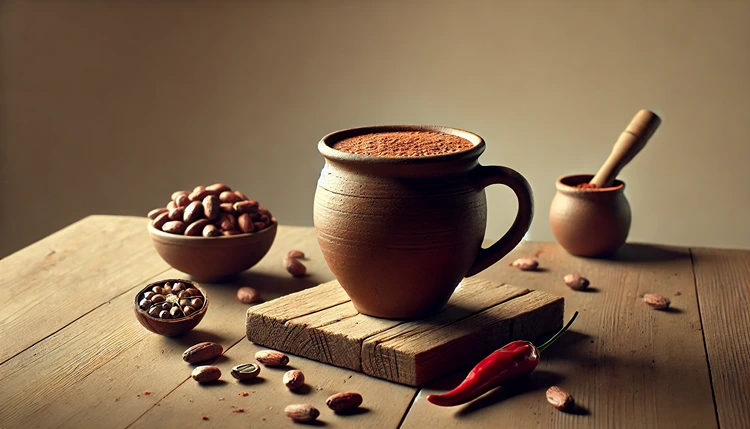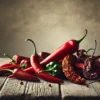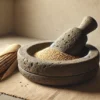The ancient Aztec chocolate drink, known as “xocolatl,” was more than just a tasty treat—it was a cultural staple. Made from ground cacao beans, water, and a few added spices, this drink was nothing like the sweet hot chocolate we enjoy today. Instead, it was a frothy, bitter beverage, revered for its energy-boosting properties and believed to have mystical qualities.
What Made Cacao So Important to the Aztecs?
The cacao bean wasn’t just a food; it was a symbol of wealth and power. The Aztecs used cacao beans as currency and reserved the drink for warriors, nobility, and religious ceremonies. They believed that cacao had the ability to nourish both the body and the soul, making it a significant part of their culture. The cacao tree was also seen as sacred, representing life and fertility.
Helpful Hint:
The ancient Aztec chocolate drink was traditionally served cold. Unlike the warm versions we enjoy today, Aztecs found the drink refreshing in its unheated form, perfect for the hot climates they lived in.
How Did the Aztecs Make Their Chocolate Drink?
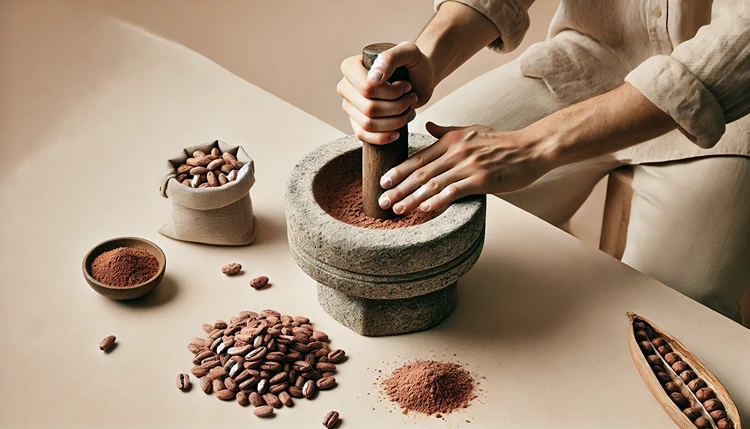
To make the ancient Aztec chocolate drink, cacao beans were fermented, dried, and roasted. Once prepared, the beans were ground into a paste, which would be mixed with water. Spices like chili and sometimes vanilla were added to enhance the flavor. This mixture was poured back and forth between containers to create a frothy texture. This frothing technique was essential, as the Aztecs believed the foam was the best part of the drink.
- Roast the cacao beans until their aroma fills the air.
- Grind the beans into a fine paste.
- Mix the cacao paste with water until smooth.
- Add spices like chili powder for a kick.
- Pour the mixture repeatedly to achieve that signature froth.
What Ingredients Did the Aztecs Use?
- Cacao Beans: The star of the show, providing a rich, bitter base.
- Water: The liquid base, essential for turning cacao into a drinkable form.
- Chili Peppers: Added for a spicy kick, balancing out the bitterness.
- Vanilla: Occasionally included to mellow the strong flavors.
- Maize or Corn Flour: Sometimes added to make the drink thicker and more filling.
Why Did the Aztecs Love Bitter Cacao?
You might be wondering why the Aztecs preferred their chocolate bitter, rather than sweet like we do today. For them, cacao was more than a luxury—it was considered a gift from the gods. The bitter flavor was part of the drink’s identity, symbolizing strength, purity, and the raw power of nature. Sweetening it would have diluted its sacred essence.
How Was Cacao Linked to Aztec Religion?
In Aztec mythology, cacao was believed to be a gift from Quetzalcoatl, the god of wisdom. This made it a sacred food, often used in religious rituals and offerings. Warriors drank the cacao beverage before battle, believing it would give them divine energy and focus. The Aztecs also thought cacao helped to open the mind and spirit, making it essential for spiritual ceremonies.
Helpful Hint:
Aztec warriors drank cacao before battle because they believed it gave them strength and endurance. This belief was rooted in the idea that cacao carried divine power, offering not just physical energy, but spiritual protection too.
How Does the Ancient Aztec Chocolate Drink Compare to Modern Hot Chocolate?
Modern hot chocolate is a far cry from the ancient Aztec version. Today’s drink is sweet, creamy, and rich, often made with milk or plant-based alternatives. It’s typically sweetened with sugar and flavored with things like cinnamon or marshmallows. In contrast, the Aztec drink was unsweetened, much more bitter, and spicier thanks to the addition of chili.
Why Was Froth So Important?
For the Aztecs, the foam was the best part of the cacao drink. The frothy texture was achieved by pouring the liquid back and forth between two containers, a process called “pouring from a height.” This aeration technique was essential, and a drink without a thick layer of foam would be considered incomplete.
Differences Between Ancient Aztec Cacao Drink and Modern Hot Chocolate
| Aspect | Ancient Aztec Cacao Drink | Modern Hot Chocolate |
|---|---|---|
| Ingredients | Cacao beans, water, chili, vanilla, maize (optional) | Cocoa powder, sugar, milk, flavorings |
| Sweetness | Bitter, unsweetened | Sweet, often with added sugar or syrups |
| Serving Temperature | Served cold | Served hot |
| Texture | Frothy, thin | Creamy, thick |
| Cultural Significance | Ritual drink, symbol of power and wealth | Comfort beverage, enjoyed worldwide |
| Health Benefits | High in antioxidants and theobromine | Often high in sugar, fewer antioxidants |
How to Make Your Own Ancient Aztec Chocolate Drink with Cacao
Want to try making your own version of this ancient drink? The ingredients are simple, but the flavor is rich and complex. Here’s a basic recipe to get started:
Ancient Aztec Chocolate Drink with Cacao
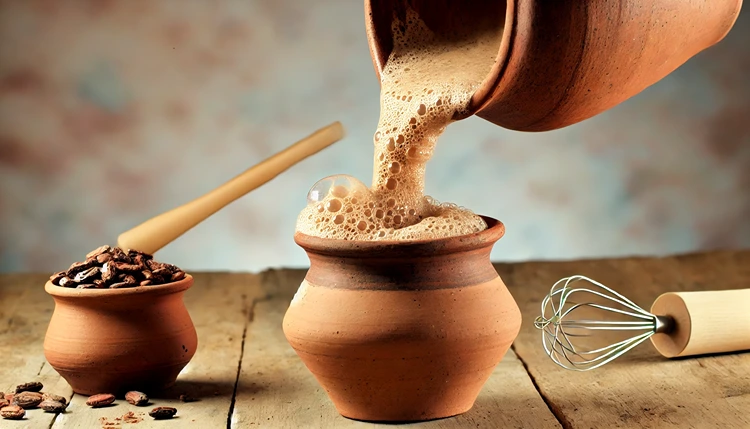
Ingredients
- 2 tablespoons cacao powder (or ground cacao beans)
- 1 cup water
- 1/4 teaspoon chili powder (optional)
- 1/4 teaspoon vanilla extract (optional)
- 1 tablespoon maize or corn flour (optional)
Instructions
- Heat water in a pot until it reaches a simmer.
- Mix in the cacao powder, stirring until it dissolves.
- Add chili powder and vanilla extract for flavor, if using.
- If you prefer a thicker drink, stir in maize or corn flour until smooth.
- Pour the mixture back and forth between two containers to create froth.
- Serve cold for an authentic Aztec experience.
Notes
For a more traditional flavor, try using ground cacao beans instead of powder. If you prefer a bit of sweetness, add a touch of agave syrup or another natural sweetener.
How Did the Aztec Chocolate Drink Influence the World?
The Aztec chocolate drink didn’t just stay within Mesoamerica—it spread far and wide. When the Spanish conquistadors arrived, they were introduced to this unique drink and took it back to Europe. Initially, the bitter flavor wasn’t a hit with Europeans, so they started sweetening it with sugar, and eventually, milk was added to create the hot chocolate we know today.
This ancient drink laid the foundation for what became a global obsession with chocolate. Its popularity grew quickly, and by the 17th century, chocolate houses were popping up all over Europe, much like modern coffee shops. The Aztecs might not recognize today’s sweet, creamy versions, but the essence of their cacao drink still resonates in modern chocolate culture.
How Did the Spanish Change the Aztec Chocolate Drink?
When the Spanish introduced cacao to Europe, it went through some major changes. The bitter, frothy drink wasn’t appealing to European palates, so they added sugar, cinnamon, and sometimes milk to make it more palatable. This shift transformed cacao from a ritual drink into a dessert beverage. Over time, chocolate became associated with luxury and indulgence, diverging significantly from its ancient roots.
Did the Aztec Chocolate Drink Include Sugar?
No, sugar wasn’t part of the traditional Aztec recipe. The concept of sweetening chocolate came later, thanks to European influence. For the Aztecs, cacao’s bitterness was intrinsic to its value. Sweetening the drink would have reduced its spiritual and physical potency. The original xocolatl was raw, bold, and entirely unsweetened.
What Are the Health Benefits of Cacao?
The Aztecs believed that cacao had medicinal properties, and modern science backs up some of their claims. Cacao is packed with antioxidants, particularly flavonoids, which can improve heart health, reduce inflammation, and even help regulate mood. The drink also contains theobromine, a natural stimulant similar to caffeine, which can boost energy without the jitteriness associated with coffee.
Can Drinking Cacao Really Boost Your Mood?
Yes, cacao can elevate your mood. It contains compounds that encourage the production of serotonin, the “feel-good” chemical in your brain. So, when the Aztecs referred to cacao as a drink that nourishes the soul, they weren’t far off! Cacao also contains phenylethylamine, a compound associated with feelings of happiness and love.
Helpful Hint:
For an energy boost without the caffeine crash, try a cup of cacao instead of coffee. Its natural theobromine content provides a smoother, longer-lasting lift.
Is It Possible to Find Authentic Aztec Chocolate Today?
While most modern chocolate drinks are far from the traditional Aztec version, there are some artisanal makers who try to replicate the ancient recipe. You can find specialty cacao powders or even ground cacao beans in some health food stores and online shops. These products are often unsweetened and made with minimal processing, so they retain the original bitter taste and rich texture.
Where Can You Try an Authentic Aztec Chocolate Drink?
If you’re lucky enough to travel to Mexico, you might come across traditional versions of this cacao drink in certain regions, particularly those that celebrate indigenous heritage. In Oaxaca, for example, chocolate is still prepared using traditional methods. You can also experiment with making your own at home using the recipe provided earlier.
Why Should You Try Making an Ancient Aztec Chocolate Drink?
Recreating an ancient Aztec chocolate drink with cacao is like taking a sip of history. It offers a glimpse into the lives of the Aztecs and their deep connection to the natural world. Plus, it’s a completely different experience from modern chocolate drinks—more raw, intense, and invigorating. It’s a chance to step out of your comfort zone and explore the origins of one of the world’s most beloved flavors.
What Makes Cacao Unique Compared to Modern Cocoa?
One major difference between cacao and modern cocoa is the level of processing. Cacao is raw or minimally processed, which means it retains more of its nutrients and natural bitterness. Modern cocoa, on the other hand, is often processed at higher temperatures and mixed with sugar and other additives to create the sweet, smooth flavors we associate with chocolate today.
FAQs
Wrapping Up
The ancient Aztec chocolate drink with cacao is a powerful reminder of how food and culture are deeply intertwined. From its role in religious ceremonies to its use as currency, this bitter and frothy drink was a staple in Aztec society. While the modern versions of hot chocolate have evolved, it’s fascinating to explore the roots of cacao and appreciate its historical significance. By recreating this ancient beverage at home, you’re not just enjoying a unique drink, but also connecting with a rich cultural tradition. So, the next time you savor your cup of chocolate, remember the deep heritage behind each sip.

